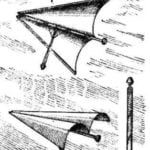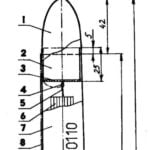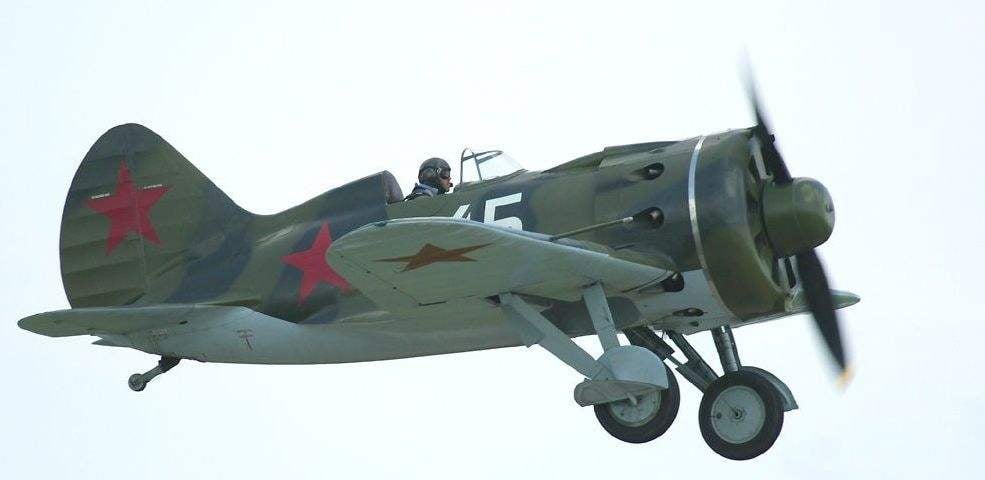Barrel-16 was performed in 1 – 1.2 seconds, and the plane was always possible to fix and in an intermediate position. Confirmed military pilots and test previously identified by the swelling of the upper cladding planes in flight with a maximum speed that was required to increase the number of ribs in the wing.
In General, drill the pilots came to the unanimous conclusion that the plane has excellent flight qualities.
Baptism of fire I-16 type 5 was held in Spain, where the fall of 1936, received the first batch of 31 vehicles. Together with the aircraft arrived and the pilots-volunteers from Bryansk air brigade, led by captain Alexander Targowym. -16 in the skies over Madrid for the first time appeared on 9 November and immediately changed the nature of air combat. This was especially true of the new admission – the fighting in the vertical as the I-16 were significantly superior to German fighter Not-51 and Italian S. K. 32. In this regard it is appropriate to quote the words of a participant of the war in Spain, A. I. Gusev:
“I-16 <…> was subordinate only to the pilot who is fluent in the technique of piloting, especially at low speeds, low altitudes, with a sharp evolutions… the loss of speed on the left turn he (the fighter. – Approx. ed.) was free to break as in the left and right spin. Not only me, but all my companions in the group, <…> And-16 resembled a skittish horse that needs a constant, incessant attention.
-16 chassis was cleaned manually. This was done so: after takeoff at low speed and the height of 15-20 meters, the pilot removed his left hand from the Gaza strip took its control knob, and the right was cleaned chassis. Had to do more than 40 turns of the handle. If the speed has increased, the chassis will not be removed without great physical effort”.
Later, when the Soviet Union brought the captured samples of the fighters, the Soviet testers noted, in particular, that “…the I-16 with all the attacks <…> SR-32 in the case of timely detection attacker could exploit the advantage of speed and climb rate to get away from the attack with a subsequent turn up, and having the advantage of height, in turn, attack the enemy.”

I-16 type 5 with the bomb armed at the airport, air force Institute
About the same was the case with the German fighter is Not-51.
But the situation in the sky of Spain began to change, when there appeared the fighter of the next generation VF.109, yet with a 680-horsepower engine Jumo-210. Compared to the Soviet fighter “Messerschmitt”, though inferior to him in speed and climb rate, has demonstrated the best maneuverability in the horizontal plane accelerates faster in a dive, and flying qualities have been much simpler.
At that time nobody thought that after a few years I-16 will meet again face to face, but with significantly upgraded In^109. But even the upgraded I-16 with a 1100 HP engine M-63 and cannon armament could not effectively compete with much “gone” forward “Messerschmitt”. Although, according to participants in the battles, 1941 – 1942, I-16 was a serious contender (especially cannon) German aces.
In early 1938, the Polikarpov design Bureau was transferred to the plant № 156, which had previously worked, was arrested in November 1937, A. N. Tupolev. To create the cannon versions of the fighter type 17 on the basis of the type 10 that the wing guns were replaced by two 20-mm cannons ShVAK. Additionally provided for suspension of up to 200 kg of bombs. Takeoff weight increased to 1810 kg. Speed was reduced to 425 km/h, deteriorated maneuverability. But it was not so important, since the aircraft was to be used against bombers, to whom he was very dangerous.
Summer in Gorky began testing the I-16 type 18 with the engine M-62 (830/900 HP) and a variable-pitch propeller (original VISH-6A, then AB-1). Armament was consistent with the type 10. Due to the heavier engine improved longitudinal stability, as the alignment moved forward and did not exceed 27.2% of the mean aerodynamic chord (SAH). The rate increased to 461 km/h, improved rate of climb.
In the same 1938 there was the I-16 type 24. The plane had the engine M-63 take-off power of 1100 HP. (nominal -930 HP). The first three M-63 plant No. 19 was produced in 1938 and until 1941, handed over to the customer 3087 motors. Radial engine M-63 was developed by designer A. D. Shvetsov on the basis of M-62 and had increased to 7.2 compression ratio vs. 6.4 at M-62.
In addition, the I-16 type 24 strengthened wing, mounted fotokinopulemeta and external fuel tanks. The maximum speed at an altitude of 4800 m was 489 km/h. Normal takeoff weight was 1780 kg, maximum -2052 kg. Cannon modifications of I-16 with this engine received factory designation type 27, 28.
In the early 1940 AND-16M-63 in accordance with the decision of Committee of Defense № 223 dated 25 may launched into serial production at the factory in Gorky. The first batch of these fighters were sent to military trials where there is lack of reliability of the aircraft. However, the release AND-16M-63 increased.
At the end of the same year, the standard of this machine is presented to the control tests in NII VVS. Compared to predecessor serial one manned jet guns – guiding beams for the suspension of rockets RS-82 caliber of 82 mm. Essential innovation for the fighter was the radio station, which gave the mast with the antenna.
All these innovations had a negative impact on the flight performance of a fighter. As follows from the report on the results of state tests, the aircraft did not eliminate the defects revealed in the early versions of the machine. In particular, it was noted the insufficient strength of the hood of the engine and exhaust pipes was not a thermal mode of operation of the motor, the fighter continued to suffer a lack of stability in flight. In addition, it was found that prolonged dive the car was sucked into this mode and at the same time due to the lack of rigidity of the wing started to rotate. The dangerous for the machine modes of the flight the pilot had to apply excessive force to the handle and the pedals to control the airplane.
Despite this, the technical Council of the air force Institute headed by its chief General A. I. Filin stated that the I-16 with the engine M-63 test stand. At the conclusion of the Institute it was noted in particular that the “plant No. 21 for a number of years ignores the NII VVS at eliminating defects of the plane I-16. Factory No. 21, with modifications of <…> And-16 is not brought to the required value of the maximum speed of the aircraft, resulting in <…> And-16 with the M-63 is significantly inferior to <…> for the fighters.”

I-16 under the wing of TB-3 SPB

I-16 type 29 with radio, external fuel tanks and rocket guns
Last-16 passed the state tests in NII VVS in summer 1940. He was equipped with the engine M-63, and the two synchronized and two wing Scusami.
After the war in Spain And 16 demonstrated their abilities in the skies of China. The peak of glory of I-16 occurred in 1939 during the fighting at Khalkhin Gol (Mongolia). Then the main opponents of Soviet pilots, there were pilots of the Japanese fighters I-96 and I-97. The latter, although he was equal in his fighting capabilities And-16, is still inferior in speed and vertical maneuver. In 1939 – 1940 “donkeys” was used in the winter war with Finland. The biggest challenge for the I-16 became the Great Patriotic war.
Despite the fact that the I-16 by the time obsolete, for some time he was still the main fighter of the early period. Soviet pilots showed to him the wonders of combat training and heroism, fighting with less advanced for that period “Messerschmitts” and “Junkers”. Not to be unfounded, I will give just a few examples of military work of the 163rd fighter regiment.
The young pilot Lieutenant Akhmetov in one of the first days of the war clashed with 15 enemy bombers before they bombed precisely.
Six-16, led by senior Lieutenant Plotnikov, collapsed on 26 enemy fighters. Destroying six cars, our pilots without loss returned to their base. By 4 July the pilots of the 163rd regiment destroyed 21 enemy aircraft, and it’s outdated machines.
Especially good in the fight against the German bombers were “donkeys” armed with two 20-millimeter guns. I-16 can be, without exaggeration, be attributed to the number of aircraft long-lived. Suffice it to say that these machines fought until 1944. In particular, the 3rd fighter squadron of the air force of the Baltic fleet was reequipped with a-16 to a more modern Yak-7 in February 1944 and joined the 21st regiment. And in the far East part of the armed I-16, he participated in the war with Japan.
Planes I-16 And the motors M-62 and M-63 was withdrawn from the aviation, defense and decommissioned in accordance with the decision of the Military Council of the air force and the Directive of the chief engineer of air defense fighter aircraft from November 20, 1945. The same thing happened with cars belonging to naval aviation and the air force.
Once is not called a fighter. In Spain, for example, nationalists, he was nicknamed “rata” (“rat”), and the Republicans – “Mosca” (“fly”). But for us he remains obstinate, the past is not one war, “the one”.
Basic data of Polikarpov I-16 type 5
Engine M-25A
Take-off power, HP 730
Wingspan, m 9
Length, m 5,99
Height, m 3,25
Wing area, m: of 14.54
Empty weight, kg 1119
Take-off weight, kg 1508
Maximum speed, km/h:
– earth 390
– at an altitude of 445
Rate of climb at ground, m/min 850
Practical ceiling, m 9100
Flight range, km 540
N. KRUGLOV
Recommend to read
 DELTA-WING ON THE ROCKET PLANE
DELTA-WING ON THE ROCKET PLANE
If you flip the binder "M-K" for a few years, then they will have a lot of materials about models of aircraft raketoplana scheme. But... time goes on and the situation changes. Three or... SPORTS EQUIPMENT OF CHAMPIONS
SPORTS EQUIPMENT OF CHAMPIONS
Before talking about the first rocket model, a few words about its designer — Alexander Tarasov. He lives in a small Siberian town of Yugorsk (Tyumen oblast), employs a facilitator Fock...
 In the summer of 1932 on the initiative of H. H. Polikarpov, who worked at the Central design Bureau began development of a promising fighter-monoplane with retractable landing gear. In may next year, the BBC confirmed their interest in the car and gave Polikarpov for the task. Six months later, the client approved the layout of the aircraft, designated the TSKB-12, and in the same month, the Council of labor and defense (STO) of the USSR adopted a decision on starting the machine received the designation I-16, in serial production.
In the summer of 1932 on the initiative of H. H. Polikarpov, who worked at the Central design Bureau began development of a promising fighter-monoplane with retractable landing gear. In may next year, the BBC confirmed their interest in the car and gave Polikarpov for the task. Six months later, the client approved the layout of the aircraft, designated the TSKB-12, and in the same month, the Council of labor and defense (STO) of the USSR adopted a decision on starting the machine received the designation I-16, in serial production.
